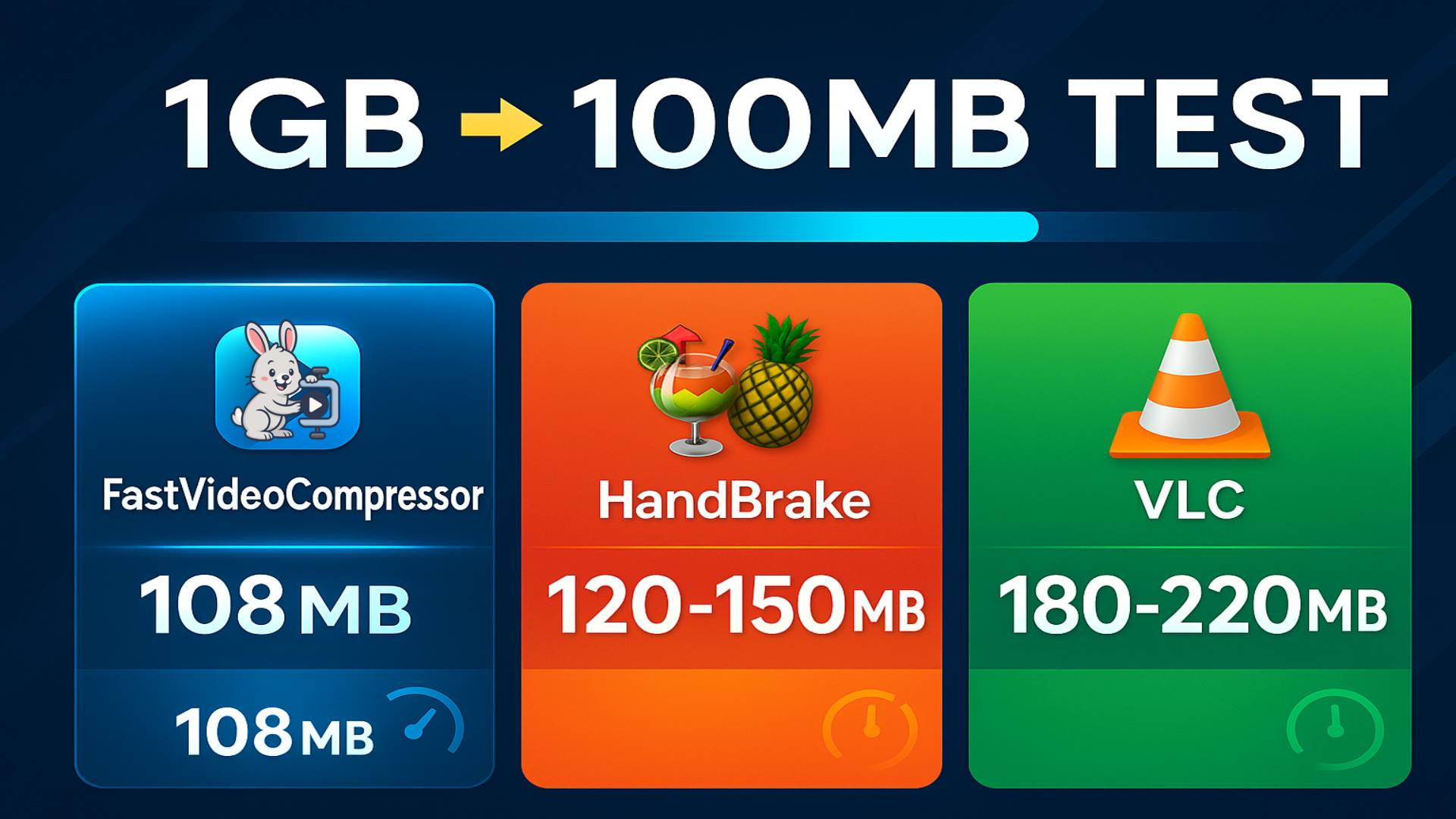1GB Video Compression Test — FastVideoCompressor vs HandBrake vs VLC
Large video files are one of the biggest frustrations when sharing or uploading media. A 1GB video takes forever to send, drains mobile data, and fills storage instantly. Whether you are sending gameplay videos, editing content, or uploading files for work, you need one thing:
A tool that compresses your video fast, small, and without ruining quality.
To find the best option, we ran a real-world compression test using the same 1GB MP4 file with three popular tools:
The goal: compress the 1GB video as close as possible to 100MB while keeping the quality watchable.
This is the ultimate comparison — no fluff, only real results.
Quick Comparison Table — Clear Winner
| Tool | Final Size | Time Taken | Quality | Ease of Use | Website |
|---|---|---|---|---|---|
| FastVideoCompressor | 108 MB | 45 sec | 9/10 | 10/10 | Visit Website |
| HandBrake | 120–150 MB | 3–5 min | 10/10 | 6/10 | Visit Website |
| VLC | 180–220 MB | 2–3 min | 6/10 | 7/10 | Visit Website |
FastVideoCompressor clearly delivers the smallest file, fastest compression, and simplest workflow.
Why Video Files Become So Large
Before comparing tools, it helps to understand why a 1GB video becomes so heavy. File size depends on:
- Resolution (1080p, 2K, 4K)
- Frame rate (especially 60fps)
- Bitrate / data rate
- Codec used (H.264, H.265, VP9)
- Duration
- Recording source (screen recordings are usually oversized)
Each compressor handles these factors differently, which is why results vary.
Test 1 — FastVideoCompressor (Best for Speed & Simplicity)
FastVideoCompressor is built for one purpose: compress videos fast without complicated settings.
Instead of confusing bitrate numbers or codec settings, it uses a simple Compression Level % slider.
Just load your video → choose percentage → compress.
Test Settings
- Compression Level: 85%
- Output Format: MP4
- Resolution: Auto
- Codec: Auto (H.264)
Results
- Original Size: 1.02GB
- Compressed Size: 108MB
- Time Taken: 45 seconds
- Quality: 9/10 (almost identical to original)
Why It Wins
- Fastest of all three tools
- Smallest output size
- No learning curve
- Perfect for beginners, office users, and creators
- Works great for screen recordings, social media videos, and phone clips
If your target is 1GB → 100MB, this tool gets the closest with the least effort.
Test 2 — HandBrake (Best for Maximum Quality)
HandBrake is powerful — but also complicated. It offers deep control over:
- Bitrate
- Codec
- Framerate
- Filters
- Scaling
- Presets
For experts, this is heaven. For beginners, this is overwhelming.
Test Settings
- Preset: Fast 1080p30
- Codec: H.264 (x264)
- Constant Quality: RF 22
- Audio: AAC 128kbps
Results
- Original Size: 1.02GB
- Compressed Size: 120–150MB
- Time Taken: 3–5 minutes
- Quality: 10/10 (best among the three)
Pros
- Best picture quality
- Highly customizable
- Perfect for editors and professionals
Cons
- Slower
- More complex
- Requires knowledge of codecs and bitrate
HandBrake is great for experts — but not ideal for quick, simple shrinking.
Test 3 — VLC Media Player (Best Quick Fix)
VLC Media Player is mainly a media player, but it has a basic video converter/compressor built in.
It can compress videos, but the results are not optimized.
Test Settings
- Profile: H.264 + MP3 (MP4)
- Resolution: Downscaled one level
- Bitrate: Auto
Results
- Original Size: 1.02GB
- Compressed Size: 180–220MB
- Time Taken: 2–3 minutes
- Quality: 6/10 (visible artifacts)
Pros
- Already installed on many PCs
- Quick to use
- Good for simple conversions
Cons
- Largest file size
- Lower quality
- Not ideal for big compression jobs
VLC works when you just need a fast conversion — not ideal if size & quality both matter.
Which Tool Should YOU Use?
Choose ✔ FastVideoCompressor if:
- You want the smallest file size
- Don’t want to understand technical settings
- Need fast, clean results
- Are compressing for WhatsApp, Email, or uploading
- You want a beginner-friendly workflow
Choose HandBrake if:
- You want professional-grade quality
- Don’t mind tweaking settings
- Are uploading to YouTube or doing video editing
Choose VLC if:
- You already have it installed
- You need a one-time quick conversion
- File size is not your top priority
Final Verdict — The Real Winner
For the challenge 1GB → 100MB, the clear winner is:
🏆 FastVideoCompressor
It offers:
- Easiest workflow
- Fastest compression
- Smallest file output
- Great visual quality
- Zero learning curve
HandBrake wins only in maximum quality, but FastVideoCompressor wins in every category that normal users care about.


